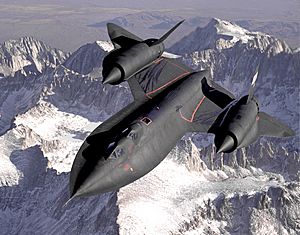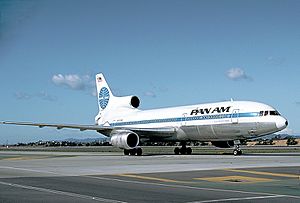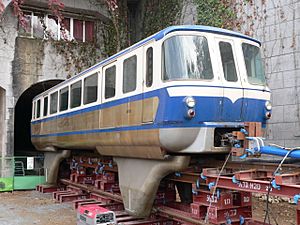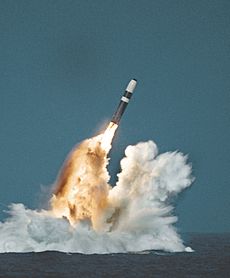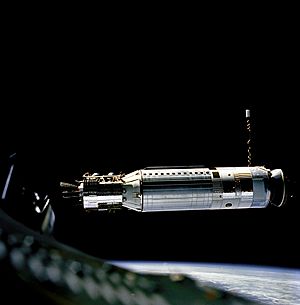Lockheed Corporation facts for kids
 |
|
| Industry | Aerospace |
|---|---|
| Fate | Merged with Martin Marietta |
| Successor | Lockheed Martin |
| Founded | December 13, 1926 |
| Founder | Allan Lockheed |
| Defunct | 1995 |
| Headquarters |
,
United States
|
|
Key people
|
|
|
Number of employees
|
90,000 |
The Lockheed Corporation was an American company that built airplanes and other things for space and defense. It started in 1926. Later, in 1995, it joined with another company called Martin Marietta. Together, they became Lockheed Martin. The person who started Lockheed, Allan Lockheed, had also started a similar company before, from 1912 to 1920.
Contents
History
How Lockheed Started
Allan Lockheed and his brother Malcolm Loughead had an earlier airplane company. It was called Loughead Aircraft Manufacturing Company. They built planes for people to take sightseeing tours in California. They also made a plane for regular passengers. But the company closed in 1920. This happened because there were too many leftover planes after World War I. Allan then worked in real estate. Malcolm started a successful company that made car brakes.
On December 13, 1926, Allan Lockheed and some friends started a new company. It was called the Lockheed Aircraft Company. They chose the name "Lockheed" to make it easier to say. This new company used some of the same ideas from their old plane designs. They used them to create the Vega Model.
In March 1928, the company moved to Burbank, California. By the end of that year, they had sold over a million dollars worth of planes. From 1926 to 1928, Lockheed built more than 80 aircraft. They had over 300 workers. By April 1929, they were building five planes every week. In July 1929, a company called Detroit Aircraft Corporation bought most of Lockheed. Allan Loughead left the company in August 1929.
The Great Depression was a very hard time for the economy. It ruined the airplane market. Detroit Aircraft went out of business. In 1932, a group of investors bought Lockheed. This group was led by brothers Robert and Courtland Gross. They bought the company for only $40,000. Allan Loughead had wanted to buy his old company back. But he could only get $50,000, which he thought was not enough.
In 1934, Robert E. Gross became the head of the new company. It was called the Lockheed Aircraft Corporation. Its main office was in Burbank, California. His brother Courtlandt S. Gross also helped start the company. He became the head after Robert died in 1961. The company's name changed to Lockheed Corporation in 1977.
The first very successful plane they built was the Vega. They made 141 of these planes, starting in 1927. The Vega is famous for many record-setting flights. Pilots like Amelia Earhart, Wiley Post, and George Hubert Wilkins flew it. In the 1930s, Lockheed spent money to develop the Model 10 Electra. This was a small plane with two engines. They sold 40 of them in the first year. Amelia Earhart tried to fly around the world in one of these planes in 1937. Later, they made improved versions like the Lockheed Model 12 Electra Junior and the Lockheed Model 14 Super Electra.
Planes Before World War II
The Lockheed Model 14 was used to create the Hudson bomber. This plane was given to the British Royal Air Force and the United States military. It was used before and during World War II. Its main job was to hunt for submarines. The Model 14 Super Electra was also sold to other countries. More than 100 were built in Japan under a special agreement. They were used by the Imperial Japanese Army.
Building Planes During World War II
When World War II began, Lockheed was asked to design a new fighter plane. This was led by Clarence (Kelly) Johnson. He is known as one of the best American aircraft designers. Lockheed created the P-38 Lightning fighter. It had two engines and a unique twin-boom design. The P-38 was the only American fighter plane that was made throughout the entire war. It was used for attacking targets on the ground, fighting other planes in the air, and even for bombing. The P-38 shot down more Japanese planes than any other U.S. Army Air Forces aircraft during the war. It is especially famous for shooting down the plane of Japanese Admiral Isoroku Yamamoto.
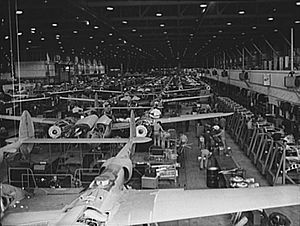
The Lockheed Vega factory was near Burbank's Union Airport. Lockheed bought the airport in 1940. During the war, the entire factory area was hidden. This was to protect it from enemy spy planes. The factory was covered with a huge canvas tarp. This tarp was painted to look like a peaceful countryside. It even had fake cars made of rubber. Hundreds of fake trees, bushes, buildings, and fire hydrants were placed to make it look real. The fake trees were made from chicken wire covered with feathers to look like leaves.
Lockheed was one of the top companies in the United States for war production. Lockheed and its part, Vega, built 19,278 aircraft during World War II. This was six percent of all war production. It included 2,600 Venturas, 2,750 Boeing B-17 Flying Fortress bombers (built under a special agreement), 2,900 Hudson bombers, and 9,000 Lightnings.
Planes After World War II

During World War II, Lockheed worked with Trans World Airlines (TWA). They developed the L-049 Constellation. This was a new type of airliner. It could carry 43 passengers between New York and London. It flew at 300 km/h and took 13 hours.
When the Constellation, nicknamed Connie, started being built, the military got the first ones. After the war, airlines received their planes. This gave Lockheed a head start over other plane makers. Everyone knew that civilian air travel would grow after the war. The Constellation's performance set new standards. It changed how people traveled by air. Its special three-tail design was because many early customers did not have hangars tall enough for a regular tail. Lockheed also made a bigger transport plane, the double-decked R6V Constitution. It was meant to replace the Constellation. But this design was not powerful enough.
Skunk Works: Secret Projects


In 1943, Lockheed secretly began to develop a new jet fighter. This was at its Burbank factory. This fighter, the Lockheed P-80 Shooting Star, was the first American jet fighter to shoot down an enemy plane. It also made the first jet-to-jet aerial kill in Korea.
Starting with the P-80, Lockheed's secret development work was done by its Advanced Development Division. This group is better known as the Skunk Works. The name came from a comic strip. This group became famous for creating many successful Lockheed designs. These include the U-2 spy plane (late 1950s), the SR-71 Blackbird (1962), and the F-117 Nighthawk stealth fighter (1978). The Skunk Works often created high-quality designs quickly. They sometimes did this with limited money and materials.
Projects During the Cold War
In 1954, the Lockheed C-130 Hercules flew for the first time. This is a strong transport plane with four engines. It is still made today. In 1956, Lockheed got a contract to develop the Polaris missile. This missile could be launched from submarines. Later, they also developed the Poseidon and Trident nuclear missiles. Lockheed also created the F-104 Starfighter in the late 1950s. It was the world's first jet fighter that could fly at Mach 2 (twice the speed of sound). In the early 1960s, the company introduced the C-141 Starlifter. This was a large jet transport plane with four engines.
During the 1960s, Lockheed started working on two big aircraft. These were the Lockheed C-5 Galaxy military transport and the Lockheed L-1011 TriStar civilian airliner. Both projects faced problems. They took longer and cost more money than planned. The C-5 had some structural weaknesses that Lockheed had to fix. The TriStar competed with another plane, the McDonnell Douglas DC-10. Delays in developing its engines caused the TriStar to fall behind. These large projects caused Lockheed to lose a lot of money in the 1970s.
Government Help
In 1971, Lockheed was facing serious financial problems. It was the largest defense contractor in the U.S. at the time. The company asked the U.S. government for help. Lockheed argued that the government should help them because the company was very important for the country's safety. After much discussion, the government agreed to guarantee a large loan for Lockheed. This helped the company avoid going out of business. Lockheed paid back the loan in 1977.
Joining with Martin Marietta
Lockheed and Martin Marietta started talking about joining forces in March 1994. They announced their plan to merge on August 30, 1994. The new company's main office would be in Maryland. The deal was completed on March 15, 1995. This is when the shareholders of both companies approved the merger. The parts of the two companies that were not kept by the new company formed L-3 Communications. This is another defense company. Lockheed Martin also later created a separate materials company called Martin Marietta Materials.
Both companies brought important products to the new combined company. Lockheed's products included the Trident missile, the P-3 Orion patrol plane, the U-2 and SR-71 spy planes, the F-117 Nighthawk stealth fighter, the F-16 Fighting Falcon, the F-22 Raptor, and the C-130 Hercules. Martin Marietta's products included Titan rockets, the Space Shuttle external tank, and various satellites.
Timeline of Lockheed
- 1912: The Alco Hydro-Aeroplane Company is started.
- 1916: Company name changes to Loughead Aircraft Manufacturing Company.
- 1926: Lockheed Aircraft Company is formed.
- 1929: Lockheed becomes part of Detroit Aircraft.
- 1932: Robert and Courtland Gross take over the company. It is renamed Lockheed Aircraft Corporation.
- 1941: The Lockheed P-38 Lightning is introduced. It was a very successful fighter in World War II.
- 1943: Lockheed's Skunk Works is founded in Burbank, California.
- 1954: The Lockheed C-130 Hercules flies for the first time.
- 1954: The Lockheed U-2 spy plane has its first flight.
- 1961: Grand Central Rocket Company is bought and becomes Lockheed Propulsion Company.
- 1962: The A-12 Blackbird flies for the first time.
- 1964: The Lockheed SR-71 Blackbird flies for the first time.
- 1970: The L-1011 TriStar has its first flight.
- 1976: The Lockheed bribery scandals happen.
- 1977: Company name changes to Lockheed Corporation. This shows it does more than just aviation.
- 1978: The company's airport in Burbank, California, is sold.
- 1981: The F-117 Nighthawk stealth fighter flies for the first time.
- 1985: Acquires Metier Management Systems.
- 1986: Acquires Sanders Associates electronics.
- 1991: Lockheed, General Dynamics, and Boeing start developing the F-22 Raptor.
- 1992: All airplane-related work stops at the Burbank facility.
- 1993: Acquires General Dynamics' Fort Worth aircraft division, which built the F-16 Fighting Falcon.
- 1995: Lockheed Corporation merges with Martin Marietta to form Lockheed Martin.
Product list
Here is a list of some of the aircraft and other vehicles Lockheed produced:
Airplanes for Passengers and Cargo
- Lockheed Vega
- Lockheed Model 10 Electra
- Lockheed Model 12 Electra Junior
- Lockheed Model 14 Super Electra
- Lockheed Model 18 Lodestar
- Lockheed Constellation, a famous airliner
- Lockheed L-049 Constellation, the first Constellation model
- Lockheed L-649 Constellation, an improved Constellation
- Lockheed L-749 Constellation, another improved Constellation
- Lockheed L-1049 Super Constellation, the largest Constellation model made
- Lockheed L-1649 Starliner, the last Constellation model
- Lockheed Saturn
- Lockheed L-188 Electra
- Lockheed JetStar, a business jet
- Lockheed L-1011 TriStar, a large passenger jet
Military Transport Planes
- Lockheed C-69/Lockheed C-121 Constellation, military versions of the Constellation
- Lockheed R6V Constitution, a large transport aircraft
- Lockheed C-130 Hercules, a medium-sized military transport plane
- Lockheed C-141 Starlifter, a long-range jet transport
- Lockheed C-5 Galaxy, a very large transport plane
Fighter Jets
- Lockheed P-38 Lightning, a twin-engine propeller fighter
- Lockheed P-80 Shooting Star, the first U.S. Air Force jet fighter
- Lockheed T-33 Shooting Star, a trainer jet
- Lockheed F-94 Starfire, an all-weather fighter
- Lockheed F-104 Starfighter, a fast interceptor jet
- Lockheed F-117 Nighthawk, a stealth fighter
- General Dynamics F-16 Fighting Falcon, a multirole fighter (originally from General Dynamics)
- Lockheed F-22, a stealth air superiority fighter
- Lockheed F-35, a stealth fighter for air and attack missions
Patrol and Reconnaissance Planes
- Lockheed Hudson, a maritime patrol and bomber plane
- PV-1 Ventura and PV-2 Harpoon, maritime patrol and bomber planes
- EC-121/WV-2 Warning Star, an AWACS (Airborne Warning and Control System) plane
- Lockheed P-2 Neptune, a maritime patrol plane
- Lockheed P-3 Orion, an ASW (Anti-Submarine Warfare) patrol plane
- Lockheed U-2/TR-1, a reconnaissance (spy) plane
- Lockheed SR-71 Blackbird, a reconnaissance (spy) plane
- Lockheed S-3 Viking, a patrol and attack plane
Helicopters
- Lockheed CL-475, a helicopter with a special rigid rotor
- XH-51A/B, a test helicopter
- Lockheed AH-56 Cheyenne, a prototype attack helicopter
Missiles
- UGM-27 Polaris
- UGM-73 Poseidon
- Trident
- UGM-96 Trident I
- UGM-133 Trident II
Space Technology
- Corona, a spy satellite
- RM-81 Agena, an advanced upper rocket stage
- Hubble Space Telescope (Lockheed helped build parts of it)
Sea Vessels
- Sea Shadow, a stealth ship
Rail Vehicles
- Odakyu Type 500 monorail (built with Kawasaki Heavy Industries)
- Himeji Monorail Type 100/200 (built with Kawasaki Heavy Industries)
See also
 In Spanish: Lockheed Corporation para niños
In Spanish: Lockheed Corporation para niños



